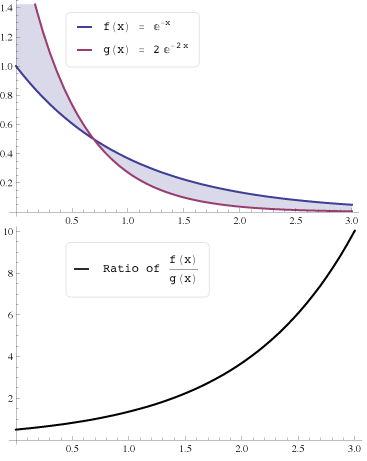Monotone likelihood ratio
The ratio of the density functions above is monotone in the parameter
satisfies the monotone likelihood ratio property.
In statistics, the monotone likelihood ratio property is a property of the ratio of two probability density functions (PDFs).
bear the property if that is, if the ratio is nondecreasing in the argument
If the functions are first-differentiable, the property may sometimes be stated For two distributions that satisfy the definition with respect to some argument
" For a family of distributions that all satisfy the definition with respect to some statistic
" The MLRP is used to represent a data-generating process that enjoys a straightforward relationship between the magnitude of some observed variable and the distribution it draws from.
As usual for monotonic relationships, the likelihood ratio's monotonicity comes in handy in statistics, particularly when using maximum-likelihood estimation.
Also, distribution families with MLR have a number of well-behaved stochastic properties, such as first-order stochastic dominance and increasing hazard ratios.
Unfortunately, as is also usual, the strength of this assumption comes at the price of realism.
Many processes in the world do not exhibit a monotonic correspondence between input and output.
, the higher the quality the more likely you worked hard.
Conversely, the lower the quality the more likely you slacked off.
Hence if some employer is doing a "performance review" he can infer his employee's behavior from the merits of his work.
This task is simplified if the family has the monotone likelihood ratio property (MLRP).
taking values in an ordered set
is said to have a monotone likelihood ratio (MLR) in the statistic
a uniformly most powerful test can easily be determined for the hypothesis
be an input into a stochastic technology – worker's effort, for instance – and
its output, the likelihood of which is described by a probability density function
Then the monotone likelihood ratio property (MLRP) of the family
Monotone likelihoods are used in several areas of statistical theory, including point estimation and hypothesis testing, as well as in probability models.
One-parameter exponential families have monotone likelihood-functions.
In particular, the one-dimensional exponential family of probability density functions or probability mass functions with has a monotone non-decreasing likelihood ratio in the sufficient statistic
Monotone likelihood functions are used to construct uniformly most powerful tests, according to the Karlin–Rubin theorem.
Monotone likelihood-functions are used to construct median-unbiased estimators, using methods specified by Johann Pfanzagl and others.
has the monotone likelihood ratio property in
But not conversely: neither monotone hazard rates nor stochastic dominance imply the MLRP.
or equivalently: Integrating this expression twice, we obtain: integrate and rearrange to obtain integrate and rearrange to obtain Combine the two inequalities above to get first-order dominance: Use only the second inequality above to get a monotone hazard rate: The MLR is an important condition on the type distribution of agents in mechanism design and economics of information, where Paul Milgrom defined "favorableness" of signals (in terms of stochastic dominance) as a consequence of MLR.
[4] Most solutions to mechanism design models assume type distributions that satisfy the MLR to take advantage of solution methods that may be easier to apply and interpret.
